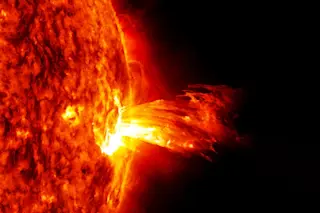Four images from NASA's Solar Dynamics Observatory of an X3.2-class flare from late at night on May 13, 2013. Starting in the upper left and going clockwise, the images show the flare in four different wavelengths. (Image: NASA/SDO) Last night the sun unleashed its latest tirade: the third flare in as many days, and the most powerful one in 2013 so far. Exploding from the Sun's surface with energy equivalent to millions of 100-megaton hydrogen bombs, the flare spewed intense radiation into space. It peaked last night at 9:11 p.m. EDT. It was not directed toward Earth, but NASA says solar material from all three of the recent flares will pass by the Spitzer Space Telescope and could give a "glancing blow" to the STEREO-B and Epoxi spacecraft. All these spacecraft can be put into a protective safe mode. The latest eruption was characterized as an X3.2-class flare. The X-class ...
New Solar Flare Packs the Power of Millions of H-Bombs
An X3.2-class flare erupted from the sun, intensifying solar flare activity observed by NASA's Solar Dynamics Observatory.
More on Discover
Stay Curious
SubscribeTo The Magazine
Save up to 40% off the cover price when you subscribe to Discover magazine.
Subscribe













